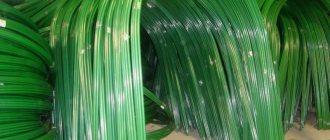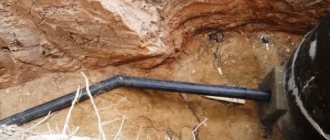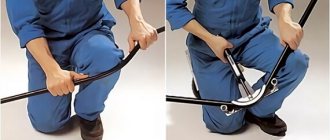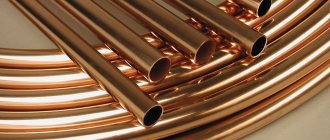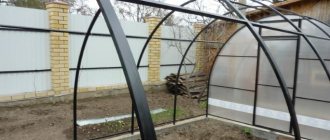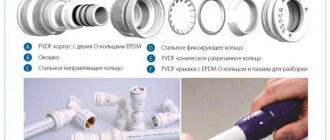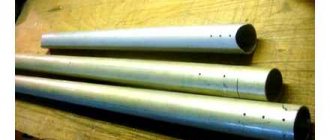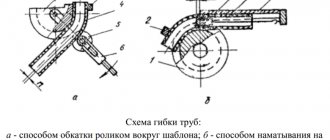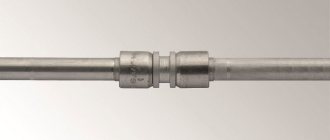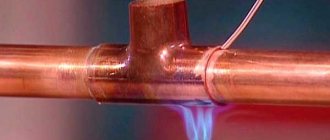It is often necessary to bend a pipe when installing communications. If the work is done by professionals, everything goes relatively quickly and simply, because companies of this profile have not only the necessary knowledge and experience, but also the appropriate tools. But what to do if you need to bend a pipe 90 degrees at home, but don’t have a pipe bender at hand? Let's consider all the options for doing this work.
Manual pipe bender
Application of the hot method
A blowtorch, a hair dryer turned on at maximum heating temperature, or a gas burner are suitable for heating metal. Sand is used as a filler. It prevents rupture of the walls during bending, the appearance of dents and bulging of the metal. To prevent the filler from spilling out, it is recommended to install temporary plugs at the ends.
Important! It is necessary to monitor the glow temperature; overheating can cause the metal to melt. The method is suitable for pipes with a cross-section over 10 cm.
Let's look at how to bend a pipe at home without an aluminum pipe bender. A sheet of paper is brought to the heated surface. If it ignites, heating should be stopped. An indicator of sufficient heating on steel structures is redness to the state of scale. It should be remembered that the metal heats up along its entire length, so the work must be done with rubber gloves.
Difficulties of the process
All metal material may be partially or entirely bent. The inversion process is carried out in two ways:
- mechanical impact;
- heating the metal.
In the first case, the metal has to be bent without heating. This method is better because the metal does not lose its properties. However, without heating the material it will be very difficult to bend the metal. When heated, it is much easier to bend, but the metal may lose its properties and become less durable.
A round metal product has approximately even characteristics. However, the profile pipe has an angle of 90°. This angle of the pipe prevents smooth bending, resulting in various folds that can subsequently burst or break.
In order not to spoil the metal, you need to clearly know how to bend a profile pipe at home. Many summer residents, not knowing the sensitivity of bending, waste a lot of material, which is subsequently thrown away.
If you examine professional equipment, you will notice that inside the rolling roller there is a special groove that presses through the middle of the wall of the profile pipe. This helps because the inner edge is compressed and there are fewer folds.
Sector welding
Often people do not know how to bend a stainless steel pipe, since stainless steel is a stronger alloy than regular steel. Of course, thanks to professional equipment this is easy to do. But what if there is nothing at hand that can provide sufficient mechanical pressure? It is for this purpose that sector welding was invented.
Its principle is that the profile product is sawed off on one side at equal distances , after which the material is bent in the required direction and the slots are welded. In this case, it is important to know that the corrugated pipe is most often thin-walled and when the slots are nearby, it is very easy to burn through it.
People who have little experience working with a tool often miss cuts, making them either too frequent or rare. To make sure the markings are correct, you can take another elastic square material and use it as a template.
If you have a gas burner on hand, the profile material can be bent using heat. Once the metal gets hot, it becomes more easily distorted, which helps prevent creases on the inside of the wall. If the bending radius is small, then you can get by with a regular clamp. But if a more precise bend is required, a guide wall will be required.
Using sand
To make a product from a bent profile pipe, you can use sand. The end of the material is tightly closed with a special plastic or copper sleeve. After this, fine sand is poured into the pipe. It is important that the product is completely filled with sand . Since the empty space inside the pipe is now tightly packed, the material will be much more easily subject to mechanical bending. The main thing is to initially create a standard according to which you can bend and guide the product.
Bend in the tree
This method is relatively often used if the pipe diameter does not exceed 15 mm. For bending to be successful, the end of the material must be tightly secured. But what to do if you can’t hold the material with your hands, and there are simply no other fastening points anywhere? And for this, the handymen came up with a fastening method. Surely there may be trees on all dacha plots. It is the tree that can serve not only as a strong fastening, but also as a diameter for bending the profile pipe.
We use fillers - sand and water
The cavities are filled with water without impurities. Plugs are attached to the ends, then frozen in the freezer or in the cold. Bending is carried out after heating with a gas burner. The procedure cannot be used for products with galvanized coating, otherwise it will be damaged.
This option is suitable for products with a large cross-section or with a square configuration. If you need to bend it at a slight angle, it is better to use sand as a filler. After thorough heating over the entire surface, the part is bent by tapping with a mallet. Galvanized structures are bent without heating.
Important! When filling a cavity with loose filler, it must be compacted so that the internal space is filled without voids. When closing the plug, a reserve is left so that it is easier to remove at the end of the procedure.
Applying templates
If deflection is necessary in several planes or at different radii, a template is used for verification. It is made from wire. Self-tapping screws can be used as a drawing. They are used for curved bends. Self-tapping screws are screwed into a rigid base, giving the desired configuration.
Bending is performed gradually, applying the product to the template for verification. The check sometimes has to be performed multiple times. When heating the surface, the minimum permissible bending size should be taken into account. It is calculated taking into account the section of the part. The smallest bend size is 3 diameters. The length of the heated section depends on the bending radius:
- 90⁰ — 6 diameters;
- 60⁰ — 4 diameters;
- 45⁰ — 3 diameters.
It is recommended to mark the deflection area on the surface with chalk. When heating, areas should be monitored for the quality of heating. If the temperature is insufficient, folds occur during deflection. The optimal temperature for heating metal parts is the appearance of scale. If the surface is overheated, it is carefully cooled with water.
How is the calculation done?
To figure out the number of cuts, you need to perform a simple calculation. Let's assume that the following conditions need to be met:
- there is a pipe measuring 30·50 mm;
- a turn at an angle of 180 ⁰ is required;
- full turning radius R = 100 mm;
- movement is carried out along the wall b = 30 mm.
It is necessary to determine the outer length of the formative half of the circle.
Lnar = π (R + b)/2
here π = 3.14 is the ratio of the circumference to the radius.
Along the way, half of the generatrix is determined along the internal radius.
Lin = π R/2
The difference between the values determines the overall width of the cuts.
C = Lout – Lin
Knowing the thickness of the saw blade (h = 2 mm), it is easy to determine the number of cuts.
n = C/h
All that remains is to substitute all the data into the calculation formula and determine the number of cuts for a 90⁰ rotation. The total quantity can be determined as:
N=2n
Calculation scheme for determining the parameters of cuts
It is better to present the calculation in the form of table 1
Table 1. Determination of the number of cuts for initial conditions
| Pipe width b, mm | 30 |
| Radius of the inner layer R, mm | 100 |
| Outer radius R out, mm | 130 |
| Length of half a circle along the outer layer Lout, mm | 408,2 |
| Half-circle length along the inner layer Lin, mm | 314 |
| Difference between the length of the outer and inner layer C, mm | 94,2 |
| Cutting width h, mm | 2 |
| Number of cuts n | 47 |
| Total number of cuts N | 94 |
People who want to build a greenhouse often ask about bending pipes using cuts. They are interested in: “How many times do you need to saw through the walls to obtain a bend with a certain radius of the generatrix?” Using the proposed dependencies, you can easily calculate the pipe grooves for the greenhouse. Table 2 shows calculations for pipes of different diameters and radii of the internal generatrix.
Table 2. Calculation for greenhouse profile pipes
| № | Pipe width b, mm | Radius of the inner layer R, mm | Outer radius R out, mm | Length of half a circle along the outer layer Lout, mm | Half-circle length along the inner layer Lin, mm | Difference between the length of the outer and inner layer C, mm | Cutting width h, mm | Number of cuts n | Total number of cuts N |
| 1 | 20 | 1000 | 1020 | 3202,8 | 3140 | 62,8 | 2,4 | 26 | 52 |
| 2 | 25 | 1000 | 1025 | 3218,5 | 3140 | 78,5 | 2,4 | 33 | 66 |
| 3 | 30 | 1000 | 1030 | 3234,2 | 3140 | 94,2 | 2,4 | 39 | 78 |
| 4 | 35 | 1000 | 1035 | 3249,9 | 3140 | 109,9 | 2,4 | 46 | 92 |
| 5 | 40 | 1000 | 1040 | 3265,6 | 3140 | 125,6 | 2,4 | 52 | 104 |
| 6 | 20 | 1250 | 1270 | 3987,8 | 3925 | 62,8 | 2,4 | 26 | 52 |
| 7 | 25 | 1250 | 1275 | 4003,5 | 3925 | 78,5 | 2,4 | 33 | 66 |
| 8 | 30 | 1250 | 1280 | 4019,2 | 3925 | 94,2 | 2,4 | 39 | 78 |
| 9 | 35 | 1250 | 1285 | 4034,9 | 3925 | 109,9 | 2,4 | 46 | 92 |
| 10 | 40 | 1250 | 1290 | 4050,6 | 3925 | 125,6 | 2,4 | 52 | 104 |
| 11 | 20 | 1500 | 1520 | 4772,8 | 4710 | 62,8 | 2,4 | 26 | 52 |
| 12 | 25 | 1500 | 1525 | 4788,5 | 4710 | 78,5 | 2,4 | 33 | 66 |
| 13 | 30 | 1500 | 1530 | 4804,2 | 4710 | 94,2 | 2,4 | 39 | 78 |
| 14 | 35 | 1500 | 1535 | 4819,9 | 4710 | 109,9 | 2,4 | 46 | 92 |
| 15 | 40 | 1500 | 1540 | 4835,6 | 4710 | 125,6 | 2,4 | 52 | 104 |
To assess the effectiveness of such technology, it is advisable to estimate the labor intensity and costs of materials (Table 3).
Table 3. Labor costs and cost of consumables for bending arcs for a greenhouse
| Number of cuts | Duration of one cut, min | Total duration of pipe sawing, min | Consumption of cutting discs with a diameter of 125 mm, pcs. | Total consumption of cutting wheels, pcs. | Duration of bending along the grooves, min | Duration of welding a seam along a cut, min |
| 52 | 0,3 | 15,6 | 0,2 | 10,4 | 0,3 | 1,3 |
| 66 | 0,3 | 19,8 | 0,2 | 13,2 | 0,3 | 1,3 |
| 78 | 0,3 | 23,4 | 0,2 | 15,6 | 0,3 | 1,3 |
| 92 | 0,3 | 27,6 | 0,2 | 18,4 | 0,3 | 1,3 |
| 104 | 0,3 | 31,2 | 0,2 | 20,8 | 0,3 | 1,3 |
| – | – | – | – | – | – | – |
| Number of cuts | Total duration of welding grooves, min | Electrode consumption 3 mm per groove on three sides | Total electrodes required, pcs. | Total process duration, min | Total duration of the process, hour | Given costs for the purchase of disks and electrodes, rub. |
| 52 | 67,6 | 0,25 | 13 | 83,5 | 1,39 | 322,4 |
| 66 | 85,8 | 0,25 | 16,5 | 105,9 | 1,77 | 409,2 |
| 78 | 101,4 | 0,25 | 19,5 | 125,1 | 2,09 | 483,6 |
| 92 | 119,6 | 0,25 | 23 | 147,5 | 2,46 | 570,4 |
| 104 | 135,2 | 0,25 | 26 | 166,7 | 2,78 | 644,8 |
How much does one steel profile pipe of size 20·20 mm cost? According to the latest data, a six-meter section can be purchased at a price of 320...360 rubles. It turns out that the cost of the process will cost about the same as the pipe itself costs. In this case, you will have to spend more than an hour and a half on one arc. The appearance of the finished products is far from perfect. To give it a marketable appearance, it is necessary to grind using an abrasive tool. This operation is comparable in time to the costs of welding work. Flap wheels will further increase direct operating costs.
Type of bent products obtained by cutting grooves followed by welding
From the presented calculations it is clear that the technology of bending pipes along a radius can be justified only for bending profile workpieces only in limited quantities. If you need to create a complex spatial structure, you should use special devices for industrial bending.
When sawing grooves, it is necessary to control the depth of cut on all three sides. A special device will be required that can limit the entry of the tool as the disk is ground down.
Rolls
Many builders are interested in how to bend a pipe at home without a pipe bender using improvised means. Parts with a diameter of up to 10 mm are bent using rollers without heating. The product is firmly fixed in a vice. When bending, the emphasis is placed on a vice, while simultaneously pressing with a roller. For workpieces with a cross-section of 40 mm , heating is required; bending them using rollers is labor-intensive.
Rolls are also used in a home-made lever pipe bender. The workpiece moves along two rollers located horizontally, and a bend is performed using a central roller. The device is suitable for arched deflection. The bend is uniform and has a large radius.
How to avoid ovalization
When carrying out “cold” bending, there are subtleties, taking into account that the cross section of the profile is preserved. To do this, limiters are installed:
- internal - does not allow the pipeline to narrow;
- external - it does not allow the side walls to expand.
It is recommended to use rigid material as a limiter; it holds its shape well.
When making a greenhouse from a profile pipe, there is no need to maintain the accuracy of the bending radius, so there is no need to spend money on buying an expensive machine.
A handy tool will do; any home craftsman has one. Using it, you can make quite a decent preparation for a greenhouse in the country.
Tips and tricks
When practicing flexibility, you need to take into account a number of circumstances:
- when purchasing a profile, make sure that they are all the same size, steel grade and belong to the same delivery batch;
- when using welded profiles, orient the side with the seam towards the inner radius, otherwise it may rupture;
- When working with an angle grinder, do not forget to use protective equipment in the form of glasses or a mask;
- It should be taken into account that the end sections cannot always be bent to the required size, therefore, when calculating the length of the workpiece, you need to take into account their length and cut off such pieces after completing the formation of the part;
- It is necessary to carry out anti-corrosion treatment of the metal and carry it out regularly in the future.
Springs
The method has proven itself well for parts with a square cross-section, but it is also suitable for pipes of other configurations. A spring of the same shape as the profile itself is required.
The spring mechanism can be made of solid steel wire. The diameter of the rod depends on the wall thickness. The spring is selected in accordance with the cross-section of the part; it can be moved in and out freely. Before bending, the metal is heated, then bent, held with pliers.
Important! You can adjust the deflection radius using a blank.
Simple ways to bend pipes
The bending method with heating is inappropriate for workpieces made of stainless steel, copper, metal-plastic and polypropylene.
Profile
Profile metal products – products with a square, oval or rectangular configuration. It is very difficult to bend them without violating the technical parameters. The best option is welding with preliminary cutting of the walls with a grinder in several places on the bend. First, cuts are made, the part is bent to the desired radius, then the seams are welded. Parts of small diameter can be soldered with a special soldering iron.
Stainless or steel
Stainless steel products cannot be bent by heating. To reduce the likelihood of deformation, various fillers are used: fine-grained sand, frozen water or calibrating plug. Rigid fillers help preserve the shape of the workpiece, elastic fillers allow less stretching of the outer wall. To obtain a uniform bend, limiters are installed both inside and outside the part.
Important! To avoid notches and defects from the calibration plug, use a lubricant: machine oil or soapy anti-corrosion emulsion.
Copper and aluminum
Aluminum and copper are quite soft. Bending can be done using cold or heated methods. Suitable fillers include sand, water, spring or rosin. The hot method is best suited for workpieces with a small diameter.
Metal-plastic
Metal-plastic blanks are bent without heating by hand, just apply some effort. Care must be taken to ensure that no kinks are formed. The permissible value is 15⁰ for every 2 cm.
The products are easily bent using wire, which is inserted into both cavities, filling the cavity evenly. Hot method is allowed. The workpiece is heated with a gas burner or a hair dryer, gradually bending it. The heating temperature is controlled with a paper sheet. Warming up should be continued until the sheet begins to smoke.
Polypropylene
It is recommended to bend polypropylene parts only if absolutely necessary. The surface is heated with a construction hairdryer to a temperature of 150⁰C, and bent by hand with gloves on without any improvised means. Using this method, you can bend workpieces with a radius equal to 8 part diameters.
Video: Tips from experts on bending different pipes
Important! When bending, a thick wall should be located on the outside, a thinner wall should be located on the bend.
When choosing a bending method, you should pay attention to the material of the part, its diameter and the required bending radius. Not all materials allow the procedure to be performed by heating. It is recommended to practice on unnecessary leftovers first. It should be remembered that it is impossible to obtain a perfect bend using improvised means. For thick-walled products, it is better to take a pipe bender.
Why do you need to know the profile characteristics?
Profile pipes differ from the standard round version in their cross-sectional shape, which can be square, oval, rectangular or flat-oval. According to GOST R regulations No. 54157-2010, a round product is also included in the list of specialized products. However, in greenhouse construction, products with a square and rectangular cross-section are most often used, for example, 40x20 mm profile pipes, because it is easier to attach the coating to their smooth, flat walls.
For a variety of national economic needs, products are produced in a wide range of sizes. It differs in configuration and cross-sectional area and, naturally, in wall thickness. The combination of sizes determines the plastic capabilities. In professional language, they are called the minimum permissible radius of curvature. This means that before you find out how to make a blank for a frame, you need to find out what is the smallest radius of flat round deformation that the blank can “survive” without damage.
To determine the minimum allowable bend radius of a square or rectangular profile, we need the height h because:
- products with a profile height of up to 20 mm will be bent without becoming unusable defective if bending is carried out on a section with a length of 2.5 × h or more;
- pipes with a profile height of over 20 mm will withstand deformation over a section of length 3.5×h or more without loss.
The indicated limits are necessary for those who are planning to make racks, shelves and frames for windows or doors. The thickness of the walls also makes adjustments to the area of limitations. Wide pipes with thin walls up to 2mm thick are generally not recommended to bend. It's better to use welding.
Home craftsmen who decide to make arcs for an arched greenhouse need to take into account that household products made from ordinary carbon or low-alloy steel alloys tend to “spring” slightly after applying force to them. They seem to be trying to return to their previous state. Consequently, after a novice mechanic completes bending all the arches with his own hands, he will have to repeat the processing and again adjust the arches to the template. It is advisable to initially take into account the value of the plastic moment of resistance Wp. It is usually indicated in the documents of the building material being sold. The smaller the moment, the less fuss there will be with the fit.

